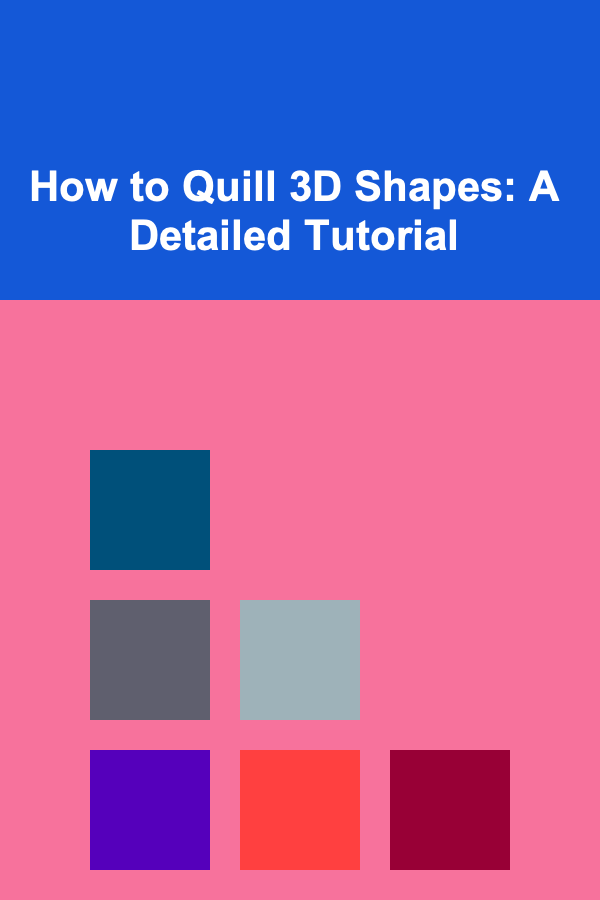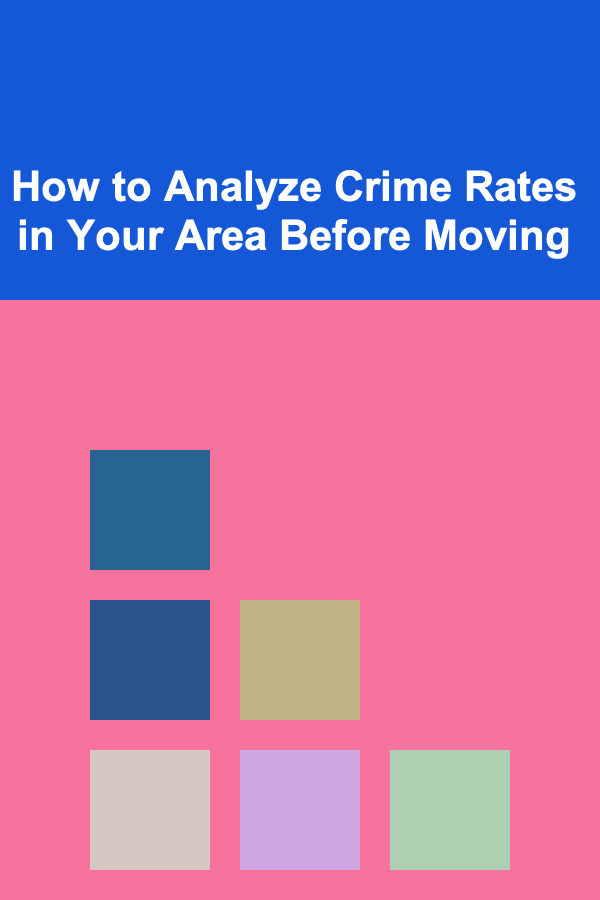
How to Quill 3D Shapes: A Detailed Tutorial
ebook include PDF & Audio bundle (Micro Guide)
$12.99$7.99
Limited Time Offer! Order within the next:

Quilling, also known as paper filigree, is an art form that involves rolling, shaping, and gluing thin strips of paper to create decorative designs. Over the years, quilling has evolved from simple 2D designs to intricate 3D shapes that can be used in a variety of projects such as greeting cards, wall art, jewelry, and more. 3D quilling takes this art form to a new level, allowing you to create visually stunning and tactile paper sculptures.
In this tutorial, we will guide you step-by-step through the process of making 3D quilled shapes, from the basics of quilling to more advanced techniques and tips for creating complex structures. By the end of this article, you will have a solid understanding of how to create your own 3D quilled shapes, whether for art or craft projects.
Materials You'll Need
Before diving into the process of quilling 3D shapes, it's essential to gather the necessary materials. You don't need a lot of expensive supplies to get started, but the quality of the materials will play a big role in the outcome of your project.
Basic Quilling Tools:
- Quilling paper strips: These are thin strips of paper, typically between 1/8-inch to 1/4-inch wide. You can find quilling paper in a variety of colors and lengths.
- Slotted tool: This tool is used to roll the paper strips into tight coils and other shapes. It has a small slot at the end that helps you hold the paper while rolling.
- Glue: Use a quick-drying, fine-tip glue for precision. A white PVA glue is a popular choice for quilling.
- Scissors: For trimming paper strips to the desired length.
- Tweezers: These are helpful for placing delicate quilled pieces accurately, especially in intricate designs.
- Ruler: For measuring the strips of paper to ensure consistent lengths.
Optional Tools for 3D Quilling:
- Quilling board: A board with pegs or holes that help you create even and precise coils and shapes.
- Needle tool: For adding fine details and creating precise coils.
- Bone folder: Used for smoothing and shaping paper folds.
- Template sheets: These are helpful for creating consistent shapes and sizes in your designs.
Step-by-Step Guide to Creating 3D Quilling Shapes
Now that you have all your materials, it's time to begin. The process of creating 3D shapes in quilling is very similar to traditional 2D quilling, but with the added challenge of shaping and attaching elements to create depth and dimension.
1. Understand Basic Quilling Shapes
Before diving into 3D quilling, it's important to be comfortable with the basic quilling shapes, as they are the foundation for more complex designs. These shapes include:
- Tight coil: This is a tight roll of paper that forms the base of most quilled shapes. It can be used to create the center of flowers, beads, or other shapes.
- Loose coil: This is a looser, more relaxed version of the tight coil and is often used for creating circular or oval shapes.
- Teardrop: A tight coil that's pinched at one end to form a drop shape.
- Marquise: A tight coil that is pinched at both ends, forming a leaf or oval shape.
- S-Shapes: These are loops created by curving the paper in opposite directions, creating a shape similar to the letter "S."
Mastering these basic shapes will make it easier to transition into creating 3D designs.
2. Forming a 3D Shape: The Foundation
For the foundation of any 3D quilling project, you will typically start with the creation of several identical elements, like coils or shapes, which you will later assemble into your 3D object.
Example 1: 3D Flower
Let's take the example of creating a 3D quilled flower.
- Start with loose coils: Create several loose coils using the paper strips. These will form the petals of the flower.
- Pinch and shape: Once you have a few coils, use your fingers or tweezers to pinch them into teardrop or marquise shapes.
- Glue the coils: Begin gluing the shapes together, forming a circular or spiral arrangement to create the outer petals of your flower.
- Form the center: Use a tight coil or a very small coil for the center of the flower.
- Shape the 3D structure: To make the flower pop into a 3D shape, glue the coils together in layers. You can slightly curve the petals to create depth by using your fingers to bend them before securing them in place.
The 3D flower will have depth because the petals will be slightly lifted off the base, giving it volume.
Example 2: 3D Bowl
- Create base coils: Start by creating multiple tight coils of the same size. These will form the base of your bowl.
- Forming the bowl shape: Arrange the coils in a circular pattern. As you stack the coils, you can glue them one by one, slightly shifting each coil so they gradually form a bowl shape.
- Add height: For a more defined 3D effect, add additional layers to build the height of the bowl.
- Secure and stabilize: Be sure to glue each coil securely to prevent the structure from collapsing.
By creating a coil that gradually expands outward and upward, you can form a 3D bowl shape.
3. Combining Shapes to Create Complex 3D Designs
When making more complex 3D quilled designs, you'll often combine several smaller shapes to build the structure. For example, in a 3D quilled animal figure, you could create separate quilled coils for the head, body, limbs, and tail, and then attach them all together.
Here's a basic example of a 3D quilled butterfly:
- Create the wings: Start by creating two large teardrop shapes for the top wings and two smaller teardrop shapes for the bottom wings.
- Pinch and form: Shape each wing shape by pinching them at the center to form a gentle curve.
- Attach the wings: Glue the wings to a central body coil, shaping them in a way that makes them appear as if they're fluttering.
- Add details: Create smaller coils or other shapes for antennae and other fine details.
- Shape the butterfly's body: Roll a tight coil for the butterfly's body and glue it between the wings.
The 3D effect comes from the raised, curved wings that give the butterfly volume and dimension.
4. Tips for Building Stability in 3D Quilling
A common challenge with 3D quilling is making sure your designs are stable and won't collapse. Here are some tips to help:
- Use strong glue: For 3D quilling, it's important to use a strong adhesive that can hold the shape in place. Quick-drying white glue is a popular choice, but be sure to use it sparingly to avoid excess glue ruining the look.
- Reinforce with cardstock: For larger 3D projects, reinforce the structure by gluing it to a sturdy piece of cardstock or cardboard. This will prevent the shape from bending or falling apart over time.
- Work in layers: Instead of building all elements at once, work in layers, allowing each layer to dry before adding the next. This will ensure the stability of the shape.
- Use quilling board: For more intricate shapes, a quilling board can be incredibly helpful for ensuring uniformity and accuracy in your shapes and sizes.
5. Creating More Advanced 3D Designs
Once you have mastered the basic 3D shapes and structures, you can experiment with more advanced designs. For example, you can create intricate 3D sculptures by combining several smaller quilled shapes to form a larger, cohesive figure, such as animals, trees, or geometric forms.
- Geometric structures: Create 3D shapes like cubes, spheres, or pyramids by gluing quilled shapes together at different angles. The combination of straight and curved paper shapes can create stunning geometric designs.
- Detailed quilled animals: Create detailed animal figures by using tightly rolled coils for the body, teardrop shapes for the legs and ears, and smaller coils for eyes and other features.
By combining these techniques, you can create complex quilled sculptures that have depth, movement, and dimension.
Final Thoughts
3D quilling is an art form that allows for endless creativity. Whether you are creating simple flowers or intricate sculptures, the possibilities are limited only by your imagination. With a little patience and practice, you can create beautiful, dimensional designs that will impress anyone who sees them.
By following the steps outlined in this tutorial and using the provided tips and examples, you'll be able to master the art of 3D quilling. Don't forget to experiment with different shapes, sizes, and colors to make your designs unique. Happy quilling!
Reading More From Our Other Websites
- [Weaving Tip 101] 10 Essential Weaving Techniques Every Beginner Should Master
- [Soap Making Tip 101] Creative Soap Making Without Lye: Adding Color, Scents, and Exfoliants Safely
- [Organization Tip 101] How to Organize Cables and Accessories in Your Music Room
- [Home Family Activity 101] How to Build a Family Playlist for Dance Parties
- [Needle Felting Tip 101] Choosing the Right Tool: Wet Felting vs. Needle Felting for Specific Projects
- [Organization Tip 101] How to Prepare for Post-Yard Sale Cleanup and Donations
- [Personal Care Tips 101] How to Use Hair Gel for Adding Texture to Hair
- [Tie-Dyeing Tip 101] Splash of Color: A Step-By-Step Guide to Tie-Dyeing Your Favorite Towel
- [Simple Life Tip 101] Best Ways to Incorporate Minimalist Design Principles into Small Apartment Spaces
- [Personal Care Tips 101] How to Use Face Serum to Reduce Acne and Scars

How to Analyze Crime Rates in Your Area Before Moving
Read More
How to Optimize Storage Solutions in Rental Units
Read More
How to Sell Handmade Pottery on Etsy: An Actionable Guide
Read More
Incorporating Active Recovery for Enhanced Performance and Well-being
Read More
10 Tips for Effective Time Management as a Founder
Read More
How to Track Student Loan Expenses as a Freelancer
Read MoreOther Products

How to Analyze Crime Rates in Your Area Before Moving
Read More
How to Optimize Storage Solutions in Rental Units
Read More
How to Sell Handmade Pottery on Etsy: An Actionable Guide
Read More
Incorporating Active Recovery for Enhanced Performance and Well-being
Read More
10 Tips for Effective Time Management as a Founder
Read More